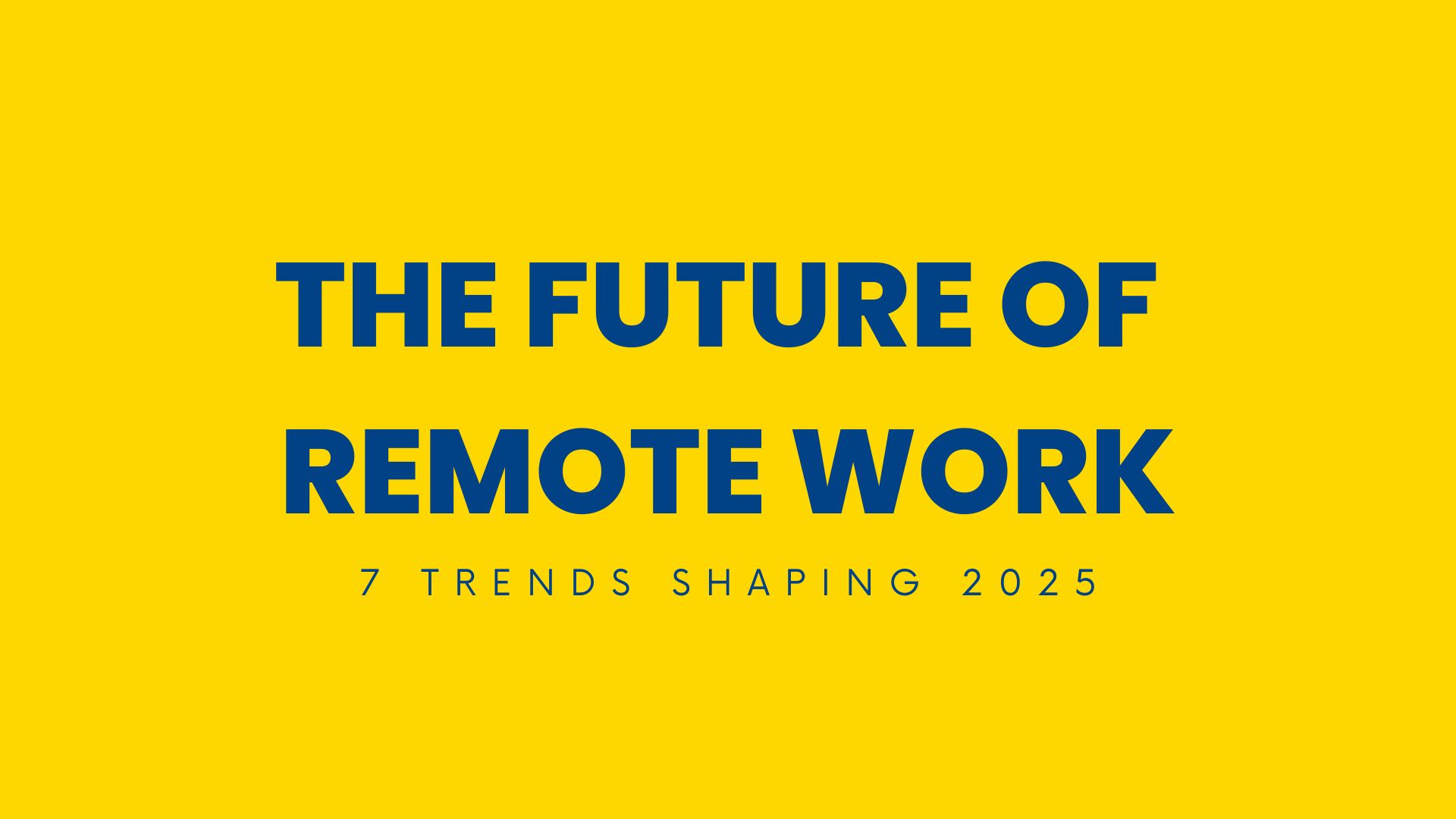What are the latest remote work trends and statistics?
The rise of remote work is no longer just a trend; it’s a necessity if you want to attract the best talent from around the globe. The era of crowded offices and daily commutes is fading, giving way to home offices and a better work-life balance that’s reshaping how we think about the standard 9-to-5. And why shouldn’t it?
With the advanced technology at our fingertips, it’s time to break free from the outdated models that stifle creativity and growth while damaging our collective mental health. The old way of working is over.
Now, it’s time to decide what the future of work will look like in 2025 and beyond. As we reinvent the modern workforce, let’s aim to design a work life that complements our personal lives, not the other way around. Never before has there been such an opportunity to grow by tapping into the collective genius of the entire world. So, let’s dive into the latest remote work statistics and see how we can all make this future a reality.
Remote Work Trend #1: More Companies Will Move From a Hybrid Model to a Fully Remote Model

Let me be real—I don’t get the point of hybrid roles. It feels like companies are clinging to that last bit of control, forcing employees who could work remotely into the office. Sure, some jobs require you to be there in person, but in those cases, hybrid doesn’t make sense anyway.
Data from the U.S. Career Institute shows:
- Over 90% of workers want some form of remote work, with the ability to work remotely becoming the most important factor in their job search.
- 79% of managers report that their teams are actually more productive when working remotely.
- Companies save an average of $10,600 per employee when they go fully remote, cutting out the overhead costs of maintaining an office.
- Remote employees save up to $12,000 per year by reducing expenses for gas, office attire, and daily lunches.
- Remote workers report lower stress levels compared to their hybrid or in-office counterparts.
The benefits are clear:
- Lower costs for both employees and companies.
- Better productivity and focus for remote teams.
- Improved mental health for remote workers.
And here’s the kicker: when you’re not limited by geography, you can tap into a global talent pool—access to better talent, sometimes at more affordable salaries, which helps grow your company with less risk and more profit.
Remote Work Trend 2: Your Workforce Will Be Global, Even If Your Company Is Not

Let’s face it—limiting your talent search to one city, or even one country, is like fishing in a pond when you’ve got an entire ocean at your disposal. In 2025, more United States companies are waking up to this reality and diving into the global talent pool. And why not? The world is full of skilled professionals just waiting to bring their expertise to your team.
Decentralized and distributed teams are on the rise. When you’re not tied down to a physical location, you can tap into a wider, more diverse range of talent. Whether you’re looking for a Shopify developer, an AI Engineer, or a creative UX designer, your options are endless when you go global.
Managing a global workforce does have difficulties to overcome. Time zones, for one, can be a logistical nightmare. And then there’s the challenge of cultural differences. What’s considered direct communication in one country might come off as rude in another. These nuances can make or break team dynamics.
So, how do you manage it all?
First, build a foundation with the right tools and communication cadences. Platforms like Slack or Microsoft Teams help keep everyone connected. Project management tools like Asana or Trello can help you stay on top of tasks across different time zones. And schedule regular check-ins at a mutually convenient time, then let everyone work when they work best. It doesn’t have to be at the same time—this is where managing remote teams becomes an art.
With the right tools and leaders that know how to manage people (by letting them do what they do best), you can easily build global teams that outperform in-house counterparts. Managing remote workers and engaging remote employees effectively are key to success in this new global landscape.
Remote Work Trend 3: AI and Automation in Remote Work

AI is now a key player in the evolution of remote work. From virtual assistants to automation tools, AI is taking on mundane tasks, allowing teams to focus on more strategic and creative work. Tools like Grammarly, ChatGPT, Claude, and Otter.ai are streamlining everything from communication to content creation, making workflows more efficient and freeing up valuable time.
The impact on productivity is undeniable. With AI handling repetitive tasks and providing data-driven insights, teams are able to operate more efficiently and make better decisions. For instance, Trello’s Butler, an AI-powered automation tool, helps streamline project management, while Zapier automates workflows between different apps, reducing manual work and boosting productivity. Advanced AI tools like ChatGPT and Claude can assist with complex problem-solving, brainstorming, and even drafting content, allowing teams to focus on high-impact tasks that drive growth.
However, with AI’s growing role comes ethical considerations, including concerns about job displacement and data privacy. Companies need to strike a balance, using AI to complement human capabilities rather than replace them. Ensuring transparency and fairness in AI-driven processes will be crucial as businesses continue to integrate these tools into their operations.
In the end, AI is here to stay, and it’s reshaping the way we work. By embracing it thoughtfully, companies can boost productivity, streamline workflows, and create new opportunities—without losing sight of the human element that makes work meaningful.
Remote Work Trend 4: The Metaverse and Virtual Collaboration Spaces

The metaverse is quickly becoming a reality in the world of remote work. Picture shared, immersive virtual office spaces where you can attend meetings, collaborate on projects, or even host company events, all from the comfort of your home office. This is where virtual reality (VR) and augmented reality (AR) come into play, offering remote teams new ways to interact and collaborate beyond the limitations of traditional video calls.
VR allows users to step into fully immersive digital environments, transforming how we brainstorm, design, and connect. Meanwhile, AR overlays digital information onto the real world, enabling a seamless blend of physical and virtual collaboration.
Companies like Meta and their Horizon Workrooms platform, and Microsoft with Mesh, are already leading the charge, developing platforms that bring remote teams together in these new virtual workspaces. Smaller firms and startups are also innovating, with platforms like Spatial offering VR spaces for virtual team building and Virbela providing virtual environments designed for remote work and online team building.
The potential of the metaverse in remote work is immense, offering a more interactive and connected experience for virtual teams spread across the globe. As businesses continue to explore this virtual frontier, we’re on the cusp of a new era where the office is no longer tied to a physical location but can be anywhere—or everywhere—all at once.
Remote Work Trend 5: Mental Health and Well-being in a Remote World

As this remote work revolution becomes the norm, companies are focusing on employee well-being and physical health, recognizing that a happy and healthy workforce is key to sustained productivity. The shift from traditional office settings to remote environments has highlighted the need for comprehensive mental health support, especially as the lines between work and personal life blur. Businesses are stepping up by integrating mental health initiatives into their core strategies, ensuring that employees feel supported no matter where they work.
To meet these needs, a variety of tools and programs have emerged, tailored specifically for remote work settings. Apps like Calm, which offers guided meditation and relaxation techniques, and Headspace, known for its mindfulness and stress management resources, have become popular among remote teams. Additionally, platforms like Happify, designed to help employees build resilience and reduce stress, are being adopted by companies that want to prioritize mental health as part of their remote work culture.
Balancing work-life integration with work-life balance is crucial in remote settings. While remote work offers flexibility, it can also lead to overwork and burnout if not managed properly. The key is to create a work culture that encourages setting boundaries and taking breaks. Tools like ToDoIst can help employees manage their time effectively, ensuring they maintain a healthy balance between work responsibilities and personal life.
By fostering an environment where well-being is prioritized, companies can help employees thrive both professionally and personally, leading to a more engaged and productive workforce.
Remote Work Trend 6: Cybersecurity in a Remote-first World

As remote work solidifies its place in the modern work landscape, cybersecurity has become more critical than ever. With employees accessing company data from various locations and devices, the risk of security breaches has skyrocketed. Companies are now prioritizing robust cybersecurity measures to protect sensitive information and ensure that managing remotely doesn’t compromise their security posture.
Common security risks like phishing attacks, unsecured Wi-Fi networks, and outdated software are more prevalent in remote settings. To mitigate these risks, businesses are turning to a combination of tools and best practices.
For example, using virtual private networks (VPNs) like NordVPN ensures secure connections, while multi-factor authentication (MFA) adds an extra layer of protection to login processes. Additionally, endpoint security solutions like CrowdStrike help monitor and safeguard devices from potential threats. Educating employees about cybersecurity best practices is also key to preventing breaches, as human error remains a significant vulnerability.
Looking ahead, future trends in remote work security are shaping up to be even more sophisticated. One of the most promising developments is the adoption of zero trust architecture, which operates on the principle of “never trust, always verify.”
This approach requires continuous verification of all users and devices, regardless of their location, to ensure they meet strict security standards before granting access. As companies increasingly embrace this model, along with advanced threat detection and response systems, the remote work environment will become more secure and resilient against emerging threats.
Remote Work Trend 7: Upskilling and Reskilling the Remote Workforce

In a rapidly evolving remote work environment, the need for continuous learning has never been more pressing. As technology advances and industries shift, employees must constantly update their skills to stay competitive. Remote work, with its flexibility, offers a unique opportunity for individuals to pursue ongoing education and skill development, but it also requires companies to be proactive in supporting this learning journey.
By 2025, certain skills are becoming essential for remote workers. Digital literacy, including proficiency with collaboration tools like Slack and project management platforms like Asana, is a given. Beyond that, remote workers are increasingly expected to have strong self-management abilities, including time management and communication skills, to thrive without direct supervision.
Data analysis, cybersecurity awareness, and AI proficiency are also rising to the forefront, as these skills empower remote teams to make data-driven decisions and navigate the complexities of modern technology.
To foster a culture of lifelong learning, companies are investing in continuous education and development programs tailored to remote work. Platforms like Coursera and Udemy offer employees access to a wide range of courses, from technical skills to leadership development. Companies are also creating internal learning portals and offering regular workshops to ensure that employees stay ahead of industry trends.
By prioritizing education and providing the resources needed for growth, businesses are not only enhancing their workforce’s capabilities but also reinforcing a culture where learning is valued and encouraged, no matter where employees are located.
Preparing for the Future of Remote Work
The trends outlined in this discussion paint a clear picture: remote work is not just a temporary shift but the foundation of the future workforce. From fully remote models to global talent pools, AI integration, and the advent of the metaverse, the way we work is undergoing a profound transformation. As companies embrace these changes, they not only unlock new levels of productivity and innovation but also create work environments that prioritize employee well-being and foster continuous learning. Managing staff remotely, engaging remote employees, and building strong virtual teams will be crucial components of success in this evolving landscape.
Odesa can help you find top talent for your global workforce. We specialize in highly skilled tech talent from Ukraine and Eastern Europe so if you’re looking for Shopify Developers, AI Engineers, Data Scientists, or UX/UI Designers, we’re here for you. Book a free strategy call today.






13 Comments
androxal fed ex cheap
order androxal new zealand buy online
enclomiphene lowest cost pharmacy
buy enclomiphene generic uae
get rifaximin cheap
canadian pharmacy for ed drugs rifaximin
discount xifaxan canada internet
buy cheap xifaxan uk sales
cheapest buy staxyn buy singapore
Online us staxyn
get avodart cheap new zealand
discount avodart cheap where
dutasteride without prescription
how to buy dutasteride low cost
buy cheap flexeril cyclobenzaprine american express canada
how to buy flexeril cyclobenzaprine generic alternatives
how to order gabapentin price on prescription
gabapentin cod shipping
online order fildena purchase discount
buy cheap fildena cheap online pharmacy
how to order itraconazole canada discount
buy cheap itraconazole generic itraconazoles
kamagra generické
kanada online lékárna kamagra
achat kamagra pharmacie nist prescrire
cheap kamagra à vendre sans prescription requise